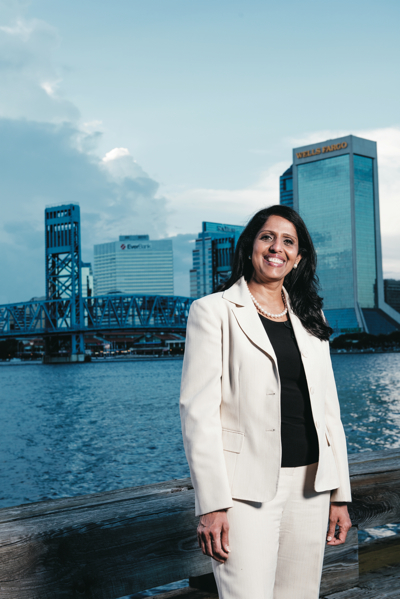Jacksonville CIO Usha Mohan Focuses on Analytics, Mobility

Credit: Jensen Hande
"I joined the city because I was excited about the opportunity to truly make a difference and the breadth of things that I could tackle."
Usha Mohan joined the city of Jacksonville, Fla., in 2012, during a time of intense fiscal constraint.
Today, the city's IT department has about 137 workers, a figure that's down some 33 percent from 2008. Under her leadership and with a can-do attitude, the staff has tackled scores of cost-cutting initiatives from renegotiating contracts and right-sizing technology to poring through data to find opportunities for savings.
Mohan spoke with StateTech Managing Editor Amy Schurr about the city's IT successes and what projects are next on the list.
StateTech: What budget challenges has the city of Jacksonville encountered in recent years?
MOHAN: I came at a time when we had lower property values across the state. The combination of decreased property revenues and increased pension costs made for very tight budgets. Over the last couple of years, we had to cut about 25 percent of our IT budget. So I came up with a three-pronged strategy for IT.
StateTech: What does that strategy entail?
MOHAN: It's dollar-focused on decreasing costs and increasing revenues; it's city-focused, which touches on automation, business intelligence, security and asset tracking; and it's citizen-focused on improving quality of life, economic development and getting on the national radar. We have a constant mindset of taking on projects that help us save money.
StateTech: How have you been able to reduce IT costs?
MOHAN: Our shared one-gigabit-per-second network is a great example of finding a way to collectively save money. We've renegotiated contracts by working with our partner agencies to get lower prices. We're constantly rightsizing the technology to see how many landlines, computers and phones we have and always try to make sure there are no extras. We restructured IT teams to do more with less. And we used server virtualization to shrink our data center down to just a few racks running 400 servers.
We spend a considerable amount of time just analyzing our IT expenses so we can figure out where else we can cut.
StateTech: What types of innovative solutions has Jacksonville found to offset budget cuts?
MOHAN: We're exploring placing ads on the splash screens of our free Wi-Fi service. We've connected small remote locations using two cellular air cards for high-speed, redundant connectivity, dropping the remote networking cost to between $50 and $80 per month. And we maintain public-safety radio services for the entire county, so that's a revenue-generating activity.
StateTech: How have you handled staffing shortages?
MOHAN: On the headcount side, we lost a lot of people through attrition. The market has become really good for IT folks so by the time we hire, we are losing another one. I think the unemployment rate in the tech sector in Jacksonville is somewhere between 1 percent and 2 percent, so that's one of our challenges.
Enhancing Efficiency
The city of Jacksonville, Fla., aims to boost government effectiveness through the following completed and potential future IT initiatives:
- Infrastructure improvements
- Business intelligence dashboards/analytics
- Security, mobile device management
- Business process management
- Cost allocation
- Interagency collaboration
- Kiosks
- Mobile apps
- Hosted enterprise resource planning
- Cloud computing
Also, we routinely take interns from the local colleges and universities. That's an inexpensive way for us to get good labor, and the kids are really good with technology — sometimes even better than the adults who we hire. We also have a high school summer job program, and we collaborate with master's degree students to work on projects over one or two semesters. They're working with real customers, and it doesn't cost us anything but time, but that's negligible compared with the value that they've added in the process.
StateTech: What IT rollouts has your department completed so far during your tenure?
MOHAN: Last year, we brought online a new courthouse brimming with technology. We've implemented free public Wi-Fi and increased IT security. And another important thing we did was to revamp the IT asset management process. Phones and notebooks tend to walk so we revamped our processes to tighten up our inventory.
And the other major thing we did was to overhaul the IT cost allocation model. The old model was really a sore point for our customers, so we came up with an IT products and services catalog of about 65 items. We have a good methodology to compute the costs of each component, so if we want to take one out and replace it with another solution, we actually know what our true cost is.
StateTech: How has the city improved data gathering and analysis?
MOHAN: We have a mainframe financial application that's difficult to use — only a handful of people across city government are experts on it. Using the Microsoft Business Intelligence suite of tools that we already owned, we created a cube for people to slice and dice, drag and drop the data and crunch millions of rows.
Since then, we've used multiple Microsoft solutions, including PowerPivot and SharePoint BI to build applications for our customers. The BI solution allowed the public works department to identify about $75,000 in missed revenue because of the intensely manual way in which they were doing billing. You can put something together quickly that produces huge value. We're on a mission to do many more of these for our customers.
StateTech: What efficiencies has the city gained with GIS?
MOHAN: We've started building all-in-one dashboards. For example, our mosquito control group uses Automatic Vehicle Locator technology and we can track the trucks with AVL on a dashboard. We know exactly where the trucks are on the map and which way they're going, along with depot information so you know where your supplies are and how much you have. As customers call in to report incidents, we map them on the same GIS dashboard and choose the closest vehicle to respond. It's a great tool to improve operational efficiency. We have a similar console that eases dispatch for our Fire and Rescue Department.
StateTech: What role does mobility play in serving citizens?
MOHAN: Whether you develop your own mobile apps or buy them, nearly every city has to have a mobile app strategy.
The first one we released was JaxReady, for emergency preparedness and public safety. JaxHapps links to our JaxHappenings website, which lists all the events happening in Jacksonville — which, by the way, is the largest city geographically in the contiguous United States. Because it's so large, it's hard to know what's going on in different parts of the city. The app pulls all the data together and puts it at the fingertips of our citizens. This aids economic development because people go to events and spend a bit of money downtown. We also have a library app and a parking app that displays which spots are available, and are developing a JaxFerry app.
StateTech: What is your vision for Jacksonville evolving into a smart city?
MOHAN: Today's IT departments can offer innovative solutions to help improve quality of life, boost economic development and public engagement and increase efficiency. It's become a key differentiator for many governments and how they use technology to connect with the citizens.
We want Jacksonville to be a "Silicon Beach," where high-tech companies can live and prosper. Jacksonville should be a city where it's a pleasure to live, work and play.
We also want to be a city where the city hall goes to the citizen — get rid of lines and move to self-service. Citizens can interact with the city from the comfort of their homes or businesses. We want to figure out a way to bring Gigabit Ethernet to all homes.







